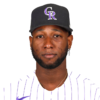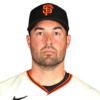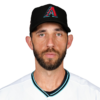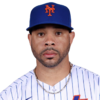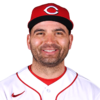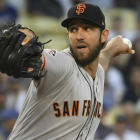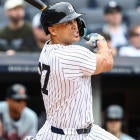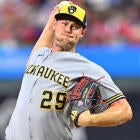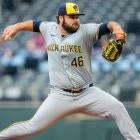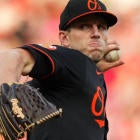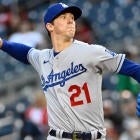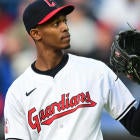I'm taking some big hacks in this one.
Sort of have to three-fourths of the way into the season. It's one thing to say "Patrick Corbin's a riser, y'all!" six weeks in, when everything's still relatively fresh and new. But with the season winding down, pointing out the clearest and most certain risers and fallers is kind of like ... no duh.
Which isn't to say all of my choices from the quarter-way and midseason dynasty updates have stuck to the script (I almost picked Rougned Odor as one of my risers this time after having him as one of my fallers last time), but there was greater conviction backing them.
So in a way, I had to think even harder about these selections. Dynasty is quite literally playing for keeps, after all, so to suggest a player has gained value for years to come, there has to be a certain level of confidence and presumption of longevity.
And to suggest a player has lost value, well ... let's just say declining production in conjunction with age is a frightening mix.
Players who've gained the most dynasty value
Jack Flaherty already had plenty of dynasty value as a top prospect who experienced early success in the big leagues, but he was still considered more a vessel of potential than a sure thing, which made transactions involving him, as with any vessel of potential, sort of like playing with funny money. After months of flirting with greatness, though, he has stepped all the way into it in August. Granted, it's only two starts, but given that everything leading up to them looked promising and he's now in the top 10 in K/9 and top 15 in swinging strike rate, ranking among the elites in both, it's time to go all-in.
Back in March, A.J. Minter seemed like a good bet to inherit the closer role at some point in 2018. But then when his strikeout and walk rates took a wrong turn in April and May, he didn't so much. Kudos to those who kept the faith and clung tightly in dynasty leagues (of which I can't count myself), because the time has arrived. Shoulder issues for Arodys Vizcaino granted the young left-hander entry right about the time he was rediscovering his form, compiling a 1.95 ERA and 0.69 WHIP with 35 strikeouts to three walks over his past 29 appearances. He was groomed for this role, and as a 24-year-old in an organization that can't afford to splurge on ace relievers in free agency, he's looking at a long stay in it.
If only because of his defense, Matt Chapman seemed like a lock to serve as the Athletics staring third baseman for years to come, but whether he'd hit enough to measure up in Fantasy remained to be seen. He has seemingly answered that question in his 36 games since returning from a hand injury, batting .331 with six homers, 16 doubles and a 1.021 OPS. It's not just that he's hot, which is a terrible way to assess a player for dynasty leagues in particular. It's that the hot streak has brought his season numbers to a place that jibes with his batted-ball profile, making him out to be something like Kyle Seager used to be — i.e., a top 12 third baseman.
Wait, but isn't Jesse Winker injured, done for the year after tearing the labrum in his right shoulder? Indeed he is, but a player's dynasty value isn't so short-sighted. And the strides he was making before the injury had taken him from "intriguing bat" to "look out, NL," his advanced plate discipline and exceptional line-drive and hard-hit rates looking an awful lot like those of Joey Votto. The power, a question mark throughout his minor-league career, had begun to show up, too, in a way that was supported by his batted-ball profile. Sure, I suppose it's possible he could lose those gains while rehabilitating the injury, but his work just before it had nonetheless elevated him from "fringe asset" to "someone to build around."
When a one-time uber prospect whose early struggles had rendered him an afterthought begins showing signs of his long-forgotten production, it's doubly exciting, and I think we're about there with Jurickson Profar. Tyler Glasnow, too, though his turnaround is still a little too fresh for him to make the cut here. Profar's production is useful enough at face value, especially given his considerable versatility and especially in points leagues, where his lack of strikeouts and surplus of doubles help set him apart. Most encouraging, though, is that his achievements have come despite horrible BABIP luck and with an ISO that suggests he may still be growing into his power at age 25.
Prospects who've gained the most dynasty value
Taylor Ward, C, Angels
The fact the Angels have recently entrusted Ward to play third base for the big club is of course a testament to his rising value, as is the fact he hit .349 with a .977 between the highest two levels of the minors this year. He won't retain catcher eligibility next year, but it's a net positive given that the move to third base seems to have sponsored his breakthrough, keeping him fresher and allowing him to tap into his athleticism in a way he couldn't in the lower minors.
Tyler O'Neill, OF, Cardinals
O'Neill also has the opportunity for a big-league audition down the stretch — one that's long overdue considering his monster power production over the past four seasons. He took it to another level this year, performing at what was a 65-homer pace if projected over 160 games. Between him getting passed over time and time again, actually changing organizations during that time, and depending on a skill that's all too prevalent in today's MLB, his dynasty appeal had been lacking. But it's clear now that his power is of a genuinely special variety.
Brandon Lowe, 2B, Rays
Lowe has already spent a couple weeks at the major-league level, and it hasn't gone well. The opportunity was entirely deserved, though based on the strides he made at Double- and Triple-A, emerging against all odds as one of the minors' most prolific home run hitters. Thought to be a solid on base-guy with no better than doubles pop, he began depositing those doubles over the fence sort of like Scooter Gennett did at the major-league level last year, and it has elevated him from also-ran status in a deep Rays system.
Touki Toussaint, SP, Braves
Speaking of also-rans in a deep system, Toussaint was rarely one of the first names mentioned when rattling off the collection of impact arms in the Braves minor-league system, but he was always thought to have one of the highest ceilings of the bunch. It was just a question of whether he'd harness his stuff well enough to stick in a starting role, and he has offered the clearest indication this year that indeed he will, most notably compiling a 1.60 ERA over his final 10 minor-league starts. He was efficient in his debut against the Marlins on Monday and has a curveball that will make your head spin.
The Dodgers' first-round pick (20th overall) in 2016 offered next to nothing offensively in his first two professional seasons but has found his form this season, learning to incorporate his lower body and drive the ball. It has resulted in a .325 batting average and .914 OPS between two spots, his production so far holding steady even after a promotion out of the heavy-hitting California League to Double-A. He's 20, so there's no rush, but it's fair to call him the team's second baseman of the future now.
Players who've lost the most dynasty value
I was a Robbie Ray apologist coming into the year but will recant it all now that it's obvious the red flags have all come home to roost. He still misses bats with the best of them, but having the 10th-lowest BABIP despite the highest hard-hit rate last year was obviously unsustainable, as was the way he barely kept a lid on the walks. Basically, strikeouts are all he's good at, and when you're failing on two of the three legs of the FIP triangle, it doesn't end well for you. There's upside still at age 26, but reliability is out the window, making Ray more of a deal sweetener than a building block.
I can't go there, can I? I shouldn't when Madison Bumgarner is only 29 and presumed to be in the prime of his career. But he just hasn't been in the same since returning from a sprained shoulder last July. Whether it's a direct result of the injury or the cumulative effect of workload abuse, he doesn't throw as hard as he used to, doesn't miss bats like he used to, doesn't get the soft contact he used to, and it's reflected in his rising ERA and increased reluctance to attack hitters. He's still solid and still pitches deep into games, but as we've seen from pitchers like Adam Wainwright and Felix Hernandez, when it goes, it goes fast. Maybe it's just a hiccup and he's as good as ever next year, but are you willing to pay for that assumption?
Tommy Pham emerged as an elite hitter across all formats last year, emerging as an on-base freak with a high-BABIP profile and the kind of power-speed combination that drives Rotisserie owners wild. But he did it at age 29 and with a history of injury and inconsistency, which meant he was working within a small window that may have already closed. Look, I'm not trying to bury the guy — his quality-of-contact stats are virtually identical to last year, in fact — but the Cardinals had become disenchanted enough to ship him, a presumed MVP candidate still in his pre-arbitration years, to the Rays for a couple of iffy prospects. Anybody who's buying into him now is doing so at a steep discount (which makes it not the worst idea, honestly).
Father Time is undefeated, as they say, and seeing as Joey Votto is approaching his 35th birthday, it's hard to spin this disappointing season as anything but negative for him. Granted, his profile is one that typically ages well, and you'd think the aging would first show up in the strikeout rate (news flash: it hasn't). But the power just hasn't been there, and besides, the players who continue to thrive at 35 and beyond are the exceptions. He probably still has a couple solid years in him, but if you were hoping to land a prospect-laden haul for him just before the start of his decline, you've probably missed your chance.
Fueled by swing changes that resulted in previously unknown power, Chris Taylor broke out last year in a way that attracted plenty of attention in Fantasy, given his versatility and spot atop the Dodgers batting order. But sort of like Robbie Ray, all of the areas where you suspected he may have overachieved last year have normalized all at once, creating a shell of the player you invested in — one without a track record to fall back on. The Dodgers clearly have their doubts, acquiring enough pieces at the deadline to push him out of the lineup completely if they wish, and while we're not there yet, he's not making a strong case to stick.















